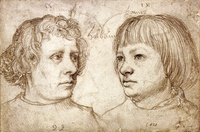Ambrosius Holbein
Ambrosius Holbein (c. 1494 – c. 1519) was a German and Swiss artist in painting, drawing and printmaking. He was the elder brother, by about three years, of Hans Holbein the Younger, but he appears to have died in his mid twenties leaving behind only a small body of work.
Ambrosius Holbein | |
|---|---|
 Hans Holbein the Elder, Portrait of his sons Ambrosius and Hans | |
| Born | Ambrosius Holbein c. 1494 |
| Died | c. 1519 (aged 24–25) |
| Nationality | German |
| Education | Hans Holbein the Elder |
| Known for | Painting |
| Movement | Northern Renaissance |

Biography
Like his younger brother, he was born in Augsburg (which today is in Bavaria, but then was a free imperial city), a center of art, culture and trade at that time. His father Hans Holbein the Elder was a pioneer and leader in the transformation of German art from the Gothic to the Renaissance style. In his studio both his sons, Ambrosius and Hans, received their first painting lessons as well as an introduction to the crafts of the goldsmith, jeweller and printmaker.
The young Holbein, alongside his brother and his father, is pictured in the left-hand panel of Holbein the Elder's 1504 altar-piece triptych the Basilica of St. Paul, which is displayed at the Staatsgalerie in Augsberg.[1]
In 1515, Ambrosius lived in the Swiss town of Stein am Rhein, where he helped a Schaffhausen painter named Thomas Schmid with the murals in the main hall of the St George monastery. The next year saw Ambrosius, as well as his brother Hans, in Basel, where he initially worked as a journeyman in Hans Herbster's studio. In 1517 he was enrolled in a register of the Basel painters' guild and in 1518 he was naturalized as a citizen there. However he disappears from records soon after, and is assumed to have died around 1519.[2]
The Portrait of a Boy with Blond Hair and its companion, the Portrait of a Boy with Brown Hair, are among Ambrosius’ best works of this period. Both are now in the Basel Kunstmuseum.
Ambrosius Holbein ranks among the most important of Basel's illustrators and prominent "small format" artists.
Works

- Virgin and Child (1514; Kunstmuseum, Basel)
- Portrait of a Boy with Blond Hair (1516; Kunstmuseum, Basel)
- Portrait of a Boy with Brown Hair (1517; Basel, Kunstmuseum, Basel)
- Portrait of Jörg Schweiger (1518; Kunstmuseum, Basel)
- Portrait of a Young Man (1515; Hessisches Landesmuseum, Darmstadt)
- Nativity (1514; Fürstlich Fürstenbergische Gemäldegalerie, Donaueschingen)
- Nativity (Klerikalseminar Georgianum, Munich)
- Repose of Mary (Klerikalseminar Georgianum, Munich)
- Portrait of Johannes Xylotectus (Zimmermann) (1520; Germanisches Nationalmuseum, Nuremberg)
- Portrait of a Young Man (1518; Hermitage Museum, St. Petersburg)
- Portrait of a Young Man (often attributed to Hans Holbein the Younger) (1518; National Gallery of Art, Washington)
- Repose of Mary (Gemäldegalerie der Akademie der bildenden Künste, Vienna)
References
- "Paintings featured in Holbein: Eye of the Tudors". bbc.co.uk. Retrieved 22 June 2020.
- Wilson, Derek. Hans Holbein: Portrait of an Unknown Man. London: Pimlico, Revised Edition, 200, pp. 69–70. Wilson cautions against too readily accepting that Ambrosius died, since other explanations for his disappearance from the record are possible. However, only Hans Holbein claimed their father's estate when he died in 1524.
See also
- Hans Holbein the Elder
- Hans Holbein the Younger
- Early Renaissance painting
External links
- Ambrosius Holbein at Artcyclopedia
- Ambrosius Holbein at ABC Gallery
- Ambrosius Holbein at the British Museum